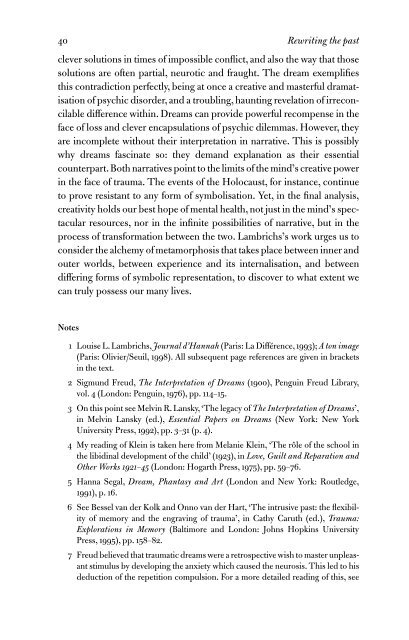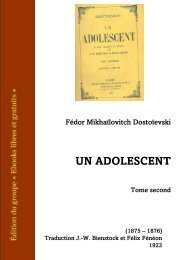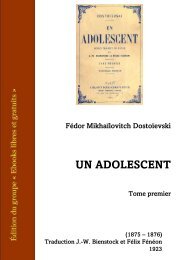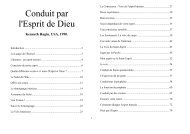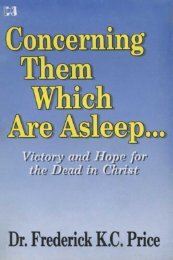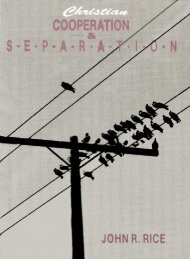Women writing in contemporary France
Create successful ePaper yourself
Turn your PDF publications into a flip-book with our unique Google optimized e-Paper software.
40 Re<strong>writ<strong>in</strong>g</strong> the past<br />
clever solutions <strong>in</strong> times of impossible conflict, and also the way that those<br />
solutions are often partial, neurotic and fraught. The dream exemplifies<br />
this contradiction perfectly, be<strong>in</strong>g at once a creative and masterful dramatisation<br />
of psychic disorder, and a troubl<strong>in</strong>g, haunt<strong>in</strong>g revelation of irreconcilable<br />
difference with<strong>in</strong>. Dreams can provide powerful recompense <strong>in</strong> the<br />
face of loss and clever encapsulations of psychic dilemmas. However, they<br />
are <strong>in</strong>complete without their <strong>in</strong>terpretation <strong>in</strong> narrative. This is possibly<br />
why dreams fasc<strong>in</strong>ate so: they demand explanation as their essential<br />
counterpart. Both narratives po<strong>in</strong>t to the limits of the m<strong>in</strong>d’s creative power<br />
<strong>in</strong> the face of trauma. The events of the Holocaust, for <strong>in</strong>stance, cont<strong>in</strong>ue<br />
to prove resistant to any form of symbolisation. Yet, <strong>in</strong> the f<strong>in</strong>al analysis,<br />
creativity holds our best hope of mental health, not just <strong>in</strong> the m<strong>in</strong>d’s spectacular<br />
resources, nor <strong>in</strong> the <strong>in</strong>f<strong>in</strong>ite possibilities of narrative, but <strong>in</strong> the<br />
process of transformation between the two. Lambrichs’s work urges us to<br />
consider the alchemy of metamorphosis that takes place between <strong>in</strong>ner and<br />
outer worlds, between experience and its <strong>in</strong>ternalisation, and between<br />
differ<strong>in</strong>g forms of symbolic representation, to discover to what extent we<br />
can truly possess our many lives.<br />
Notes<br />
1 Louise L. Lambrichs, Journal d’Hannah (Paris: La Différence, 1993); A ton image<br />
(Paris: Olivier/Seuil, 1998). All subsequent page references are given <strong>in</strong> brackets<br />
<strong>in</strong> the text.<br />
2 Sigmund Freud, The Interpretation of Dreams (1900), Pengu<strong>in</strong> Freud Library,<br />
vol. 4 (London: Pengu<strong>in</strong>, 1976), pp. 114–15.<br />
3 On this po<strong>in</strong>t see Melv<strong>in</strong> R. Lansky, ‘The legacy of The Interpretation of Dreams’,<br />
<strong>in</strong> Melv<strong>in</strong> Lansky (ed.), Essential Papers on Dreams (New York: New York<br />
University Press, 1992), pp. 3–31 (p. 4).<br />
4 My read<strong>in</strong>g of Kle<strong>in</strong> is taken here from Melanie Kle<strong>in</strong>, ‘The rôle of the school <strong>in</strong><br />
the libid<strong>in</strong>al development of the child’ (1923), <strong>in</strong> Love, Guilt and Reparation and<br />
Other Works 1921–45 (London: Hogarth Press, 1975), pp. 59–76.<br />
5 Hanna Segal, Dream, Phantasy and Art (London and New York: Routledge,<br />
1991), p. 16.<br />
6 See Bessel van der Kolk and Onno van der Hart, ‘The <strong>in</strong>trusive past: the flexibility<br />
of memory and the engrav<strong>in</strong>g of trauma’, <strong>in</strong> Cathy Caruth (ed.), Trauma:<br />
Explorations <strong>in</strong> Memory (Baltimore and London: Johns Hopk<strong>in</strong>s University<br />
Press, 1995), pp. 158–82.<br />
7 Freud believed that traumatic dreams were a retrospective wish to master unpleasant<br />
stimulus by develop<strong>in</strong>g the anxiety which caused the neurosis. This led to his<br />
deduction of the repetition compulsion. For a more detailed read<strong>in</strong>g of this, see


